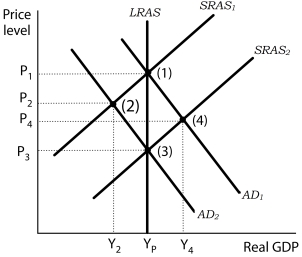Multiple Choice
Figure 17-2 
-Refer to Figure 17-2. The economy is initially in equilibrium at point (1) . Now suppose a reduction in the money supply causes aggregate demand to fall to AD2. The below potential output level of Y2 will exist as long as
A) policymakers refrain from using discretionary policies.
B) workers fail to recognize that their real wages have increased and that they need to accept lower nominal wages.
C) economic agents do not respond to falling prices by increasing aggregate demand back to AD1.
D) producers do not increase the price of their output.
Correct Answer:

Verified
Correct Answer:
Verified
Q6: Suppose the U.S. economy experiences stagflation. An
Q18: The monetarist school of economics believes that
Q46: In 1965 during the Johnson administration, the
Q62: The theory that argues most strongly for
Q75: Who was the economist who laid the
Q93: Monetarists argue that impact lags associated with
Q99: Monetarists argue that:<br>A) the impact lag for
Q100: An important distinction between the classical and
Q103: Figure 17-3 <img src="https://d2lvgg3v3hfg70.cloudfront.net/TB5507/.jpg" alt="Figure 17-3
Q110: Keynes believed that wages and prices were